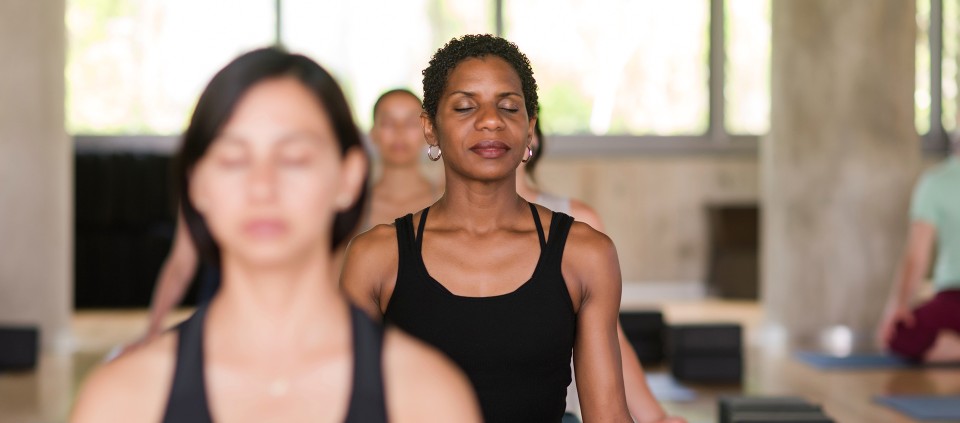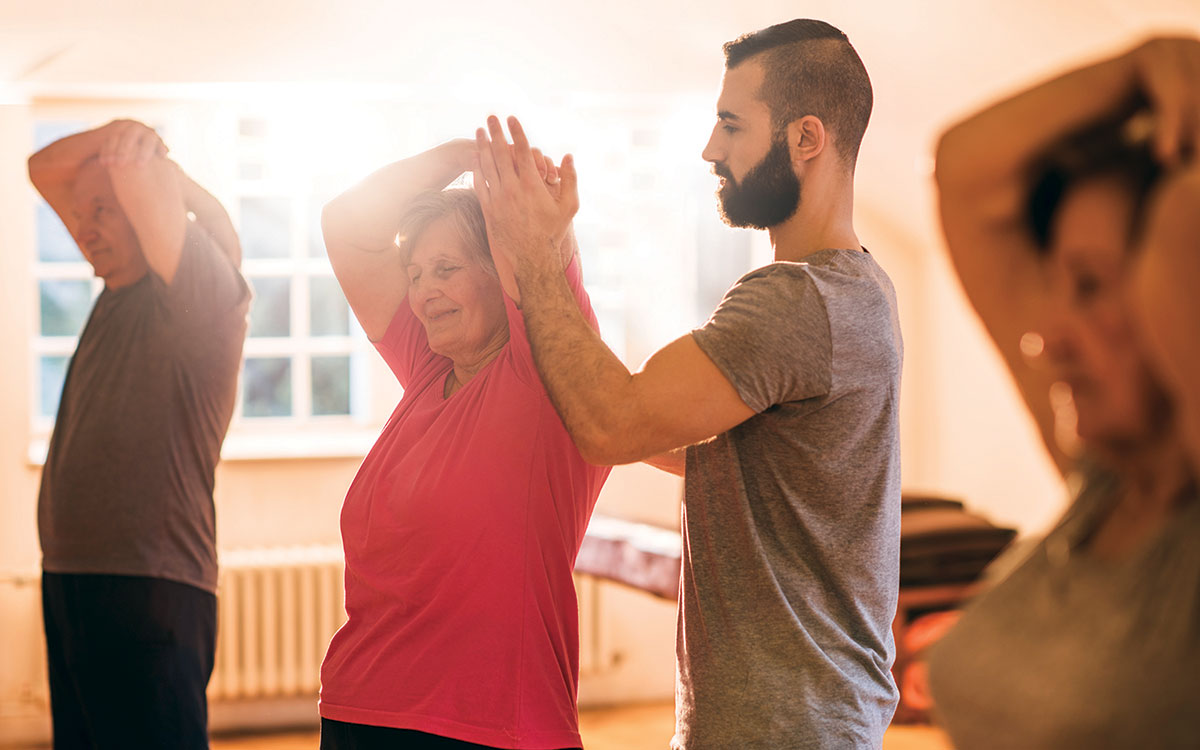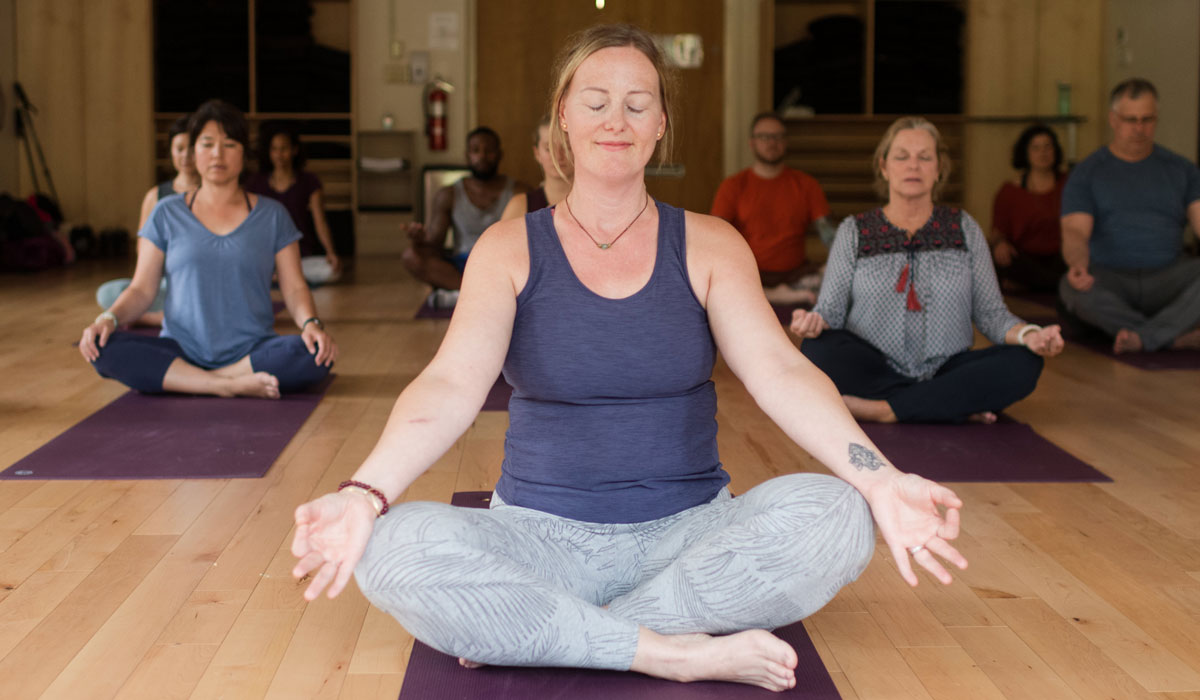Yoga Therapy for Anxiety: Six Practices to Try

When we activate the healing power of yoga to address anxiety, the primary goal is to help regulate the nervous system. In working with an individual or teaching a class designed for this population, a yoga therapist seeks to gradually promote relaxation in mind and body.
Since anxiety often produces a sense of being outside of our bodies and outside of the moment—focused on either the future or the past—yoga is supportive because it fosters embodiment and the ability to be grounded in the present. In addition, movement and breath can create a sort of container that eases the feeling of being out of control that often comes with anxiety.
When viewed through the lens of the gunas—the three qualities that make up the entire universe, according to yoga philosophy—anxiety would be understood as a state in which rajas (the guna related to activity and activation) is predominant. We can use asana, pranayama, and meditation to shift into a more sattvic (balanced and harmonious) state.
Here are six exercises that might be included in a yoga therapy protocol for anxiety. You can try them on your own as well. Please remember, however, that yoga should serve as a complementary approach for mental-health disorders, supplemented with appropriate counseling and other interventions.
Body-Awareness Exercise
Begin seated. Bring your attention to each part of the body in turn, beginning at the head and moving down to the toes. As you scan each body part, allow some gentle movements in that area. Turn the head to the right and back to center, then to the left and back to center. Lift the shoulders and lower them slowly, repeating several times. Tense and release the muscles in your arms and legs. Roll the joints of the wrists and ankles. Focusing on different areas of the body and noticing sensations without judging them may help facilitate relaxation; the body becomes an anchor that steadies the mind.
Sun Breaths
In a standing or seated position, inhale and lift the arms out to the sides and overhead, bringing the palms together. Exhale while releasing the arms down to the sides, or to the heart center, palms together. Repeat at your own pace, finding your natural rhythm with the breath. When we’re anxious, the breath tends to be in the chest rather than the belly; synchronizing movement with breath—without controlling the breath in any other way—deepens the inhalations and exhalations, catalyzing the nervous system to move into the relaxation response.
Pursed-Lips Breath (Kaki Pranayama)
Anxiety can sometimes cause tightness in the chest and shortness of breath. In these cases, I often recommend Kaki pranayama, also called Pursed-Lips Breath. Inhale gently through the nose, as if you were sniffing a rose. Then exhale through the mouth with the lips pursed, as if you were blowing out through a straw. The exhalation is so soft that a candle in front of you would flicker but not go out. Repeat several times, breathe normally, and repeat for another round or two.
Guided Imagery
Guided imagery is an evidence-based tool for relieving anxiety; one recent study found that nature-based guided imagery was particularly effective as an intervention for anxiety. Visualize a walk in the garden or along the beach, activating the senses: Feel the sun and the warm breeze on your face, imagine the color and scent of the flowers, listen to the birds calling. You can find lots of guided imagery options online or on apps like Calm or Headspace.
Meditation with a Mudra
Mudras can have immediate energetic effects, and can serve as a focal point for the body and mind in meditation. Adi Mudra is a simple mudra used to calm and quiet the mind and nervous system. It’s also thought to increase lung capacity and thus oxygen flow in the body. Press the thumb to the inside of the palm and close the fingers around it, making a gentle fist. Rest the fisted hands softly on your knees, while in seated meditation, focusing on the breath. Continue for three to five minutes, or longer if you wish.
Mountain Pose with an Affirmation
Come into Mountain pose. While holding the pose, work with a bhavana, a yogic contemplation or vision; we could also call it a positive affirmation. You might try: I am supported, I am present, or I am calm. Visualize the qualities of the earth—grounded, nurturing, and stable—supporting you and your intention.
Mary Northey, C-IAYT, director of the Kripalu School of Integrative Yoga Therapy, has a yoga therapy practice in her hometown and brings yoga therapy to populations in need.
Full Bio and Programs
